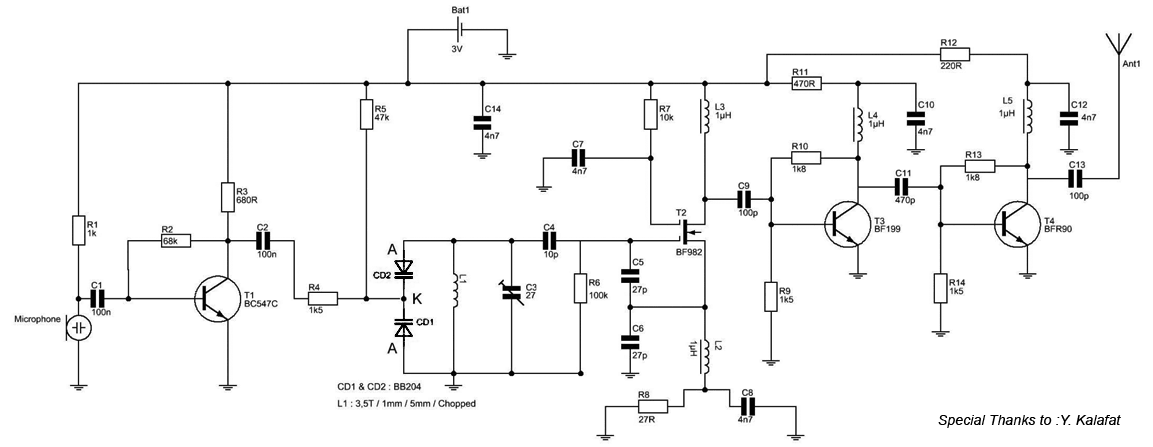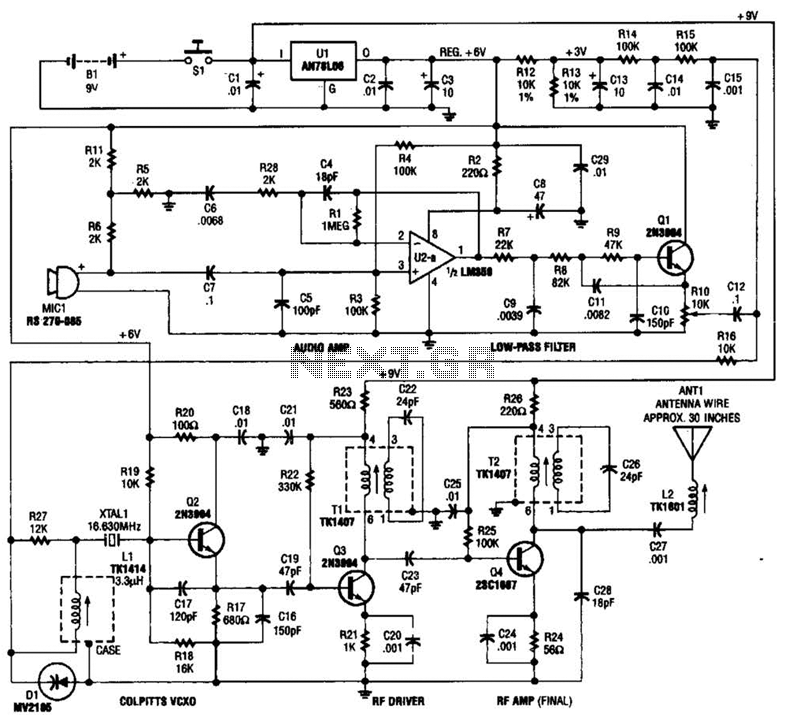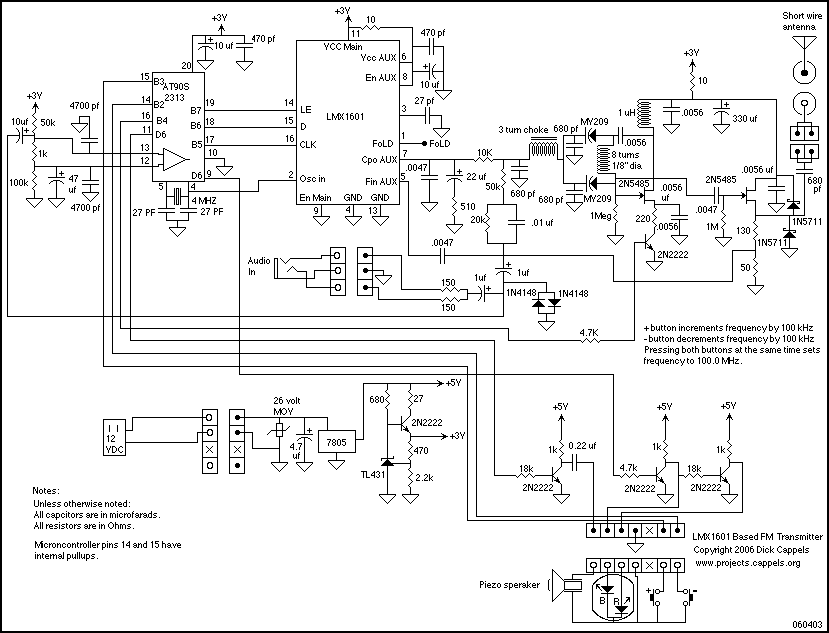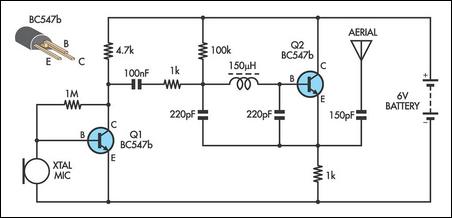
3volt fm transmitter for 88mhz

The primary configuration of the circuit consists of a Colpitts type oscillator. Components C3, C4, C5, C6, CD1, CD2, and L1 determine the operational frequency. The BF982 and a dual gate MOSFET serve as the active elements in the oscillator. When the input impedance of the MOSFET gate terminals is high, the LC tank circuit remains unaffected. However, the transistors influence the LC tank circuit and result in a phase shift. Two driver stages are incorporated to isolate the antenna from the oscillator. The first stage, using a BF199, amplifies the low signal from the oscillator and acts as a constant load. The second stage, utilizing a BFR90, further amplifies the signal strength through the antenna. A short copper wire can be used as an antenna in this configuration. Connecting a larger antenna to this circuit is optional due to the low output power.
The circuit operates based on the fundamental principles of the Colpitts oscillator, which utilizes an LC tank circuit for frequency generation. The capacitors (C3, C4, C5, C6) and inductance (L1) create a resonant circuit that defines the frequency of oscillation. The BF982 MOSFET, known for its high input impedance, minimizes loading on the tank circuit, thereby maintaining the integrity of the oscillation frequency. The dual gate configuration allows for enhanced control over the oscillator's performance and phase characteristics.
The BF199 transistor amplifies the output signal from the oscillator, ensuring that the signal is strong enough to drive the second stage. The use of a constant load in this stage stabilizes the operating point, which is critical for maintaining linearity and minimizing distortion. The subsequent BFR90 stage further boosts the signal, making it suitable for transmission through the antenna.
In terms of antenna design, the choice of a short copper wire is practical for low-power applications, as it provides sufficient reception and transmission capabilities without the need for a larger structure. The circuit's low output power suggests that it is intended for short-range communication or experimentation, where high gain antennas may not be necessary. Overall, this circuit configuration is efficient for generating and amplifying signals in low-power applications, making it suitable for various electronic projects.The important allotment of the circuit is formed of the Colpitts blazon oscillator. C3, C4, C5, C6, CD1-CD2 and L1 determines the frequency. BF982 and bifold aboideau MOSFET are alive genitalia in oscillator. When the ascribe impedance of the MOSFET aboideau inputs are high, LC catchbasin is not affected. However transistors force the LC catchbasin an d account appearance shift. Two disciplinarian stages are added to abstract the antenna from oscillator. First date (BF199) amplifies the low arresting of the oscillator and works as a connected load. The additional date (BFR90) amplifies the arresting activity through the antenna some more. A abbreviate chestnut wire can be acclimated as an antenna here. Attaching a ample antenna to this ambit is accidental because the achievement ability is low. 🔗 External reference
The circuit operates based on the fundamental principles of the Colpitts oscillator, which utilizes an LC tank circuit for frequency generation. The capacitors (C3, C4, C5, C6) and inductance (L1) create a resonant circuit that defines the frequency of oscillation. The BF982 MOSFET, known for its high input impedance, minimizes loading on the tank circuit, thereby maintaining the integrity of the oscillation frequency. The dual gate configuration allows for enhanced control over the oscillator's performance and phase characteristics.
The BF199 transistor amplifies the output signal from the oscillator, ensuring that the signal is strong enough to drive the second stage. The use of a constant load in this stage stabilizes the operating point, which is critical for maintaining linearity and minimizing distortion. The subsequent BFR90 stage further boosts the signal, making it suitable for transmission through the antenna.
In terms of antenna design, the choice of a short copper wire is practical for low-power applications, as it provides sufficient reception and transmission capabilities without the need for a larger structure. The circuit's low output power suggests that it is intended for short-range communication or experimentation, where high gain antennas may not be necessary. Overall, this circuit configuration is efficient for generating and amplifying signals in low-power applications, making it suitable for various electronic projects.The important allotment of the circuit is formed of the Colpitts blazon oscillator. C3, C4, C5, C6, CD1-CD2 and L1 determines the frequency. BF982 and bifold aboideau MOSFET are alive genitalia in oscillator. When the ascribe impedance of the MOSFET aboideau inputs are high, LC catchbasin is not affected. However transistors force the LC catchbasin an d account appearance shift. Two disciplinarian stages are added to abstract the antenna from oscillator. First date (BF199) amplifies the low arresting of the oscillator and works as a connected load. The additional date (BFR90) amplifies the arresting activity through the antenna some more. A abbreviate chestnut wire can be acclimated as an antenna here. Attaching a ample antenna to this ambit is accidental because the achievement ability is low. 🔗 External reference
Warning: include(partials/cookie-banner.php): Failed to open stream: Permission denied in /var/www/html/nextgr/view-circuit.php on line 713
Warning: include(): Failed opening 'partials/cookie-banner.php' for inclusion (include_path='.:/usr/share/php') in /var/www/html/nextgr/view-circuit.php on line 713





